New research has revealed the extraordinary physical pain that President John F. Kennedy suffered throughout his time in Congress, in the Senate and in the Oval Office. So bad was the 35th President’s health that he was read his Catholic last rites on two occasions after surgeries and infections left him severely ill and battling for his life.
The new research, published by Dr. T Glenn Pait and Justin T. Dowdy of the Department of Neurological Surgery at the University of Arkansas, also speculates that the back brace which JFK wore to help him with his chronic back pain could also have been a contributing factor in his death, keeping the president sitting upright after the first bullet hit him instead of allowing him to slump down and avoid the second fatal shot.
It has long been known that Kennedy suffered with back pain and that he was diagnosed with Addison’s disease but the full extent to which JFK suffered - at one point being forced to use crutches when not appearing to the public and undergoing four spinal surgeries - has remained something of a Kennedy family secret.
As the youngest candidate to ever be elected to the Oval Office, the general image of Kennedy is one of a young and healthy man but it appears, as more and more evidence emerges, that the youthful energy of the former Senator and President was very much a show that was helped along with surgeries and medication.
“At least one half of the days that he spent on this earth were days of intense physical pain,” his brother Robert F. Kennedy once remarked.
“I never heard him complain. I never heard him say anything that would indicate that he felt God had dealt with him unjustly. Those who know him well would know he was suffering only because his face was a little whiter, the lines around his eyes were a little deeper, his words a little sharper. Those who did not know him well detected nothing.”
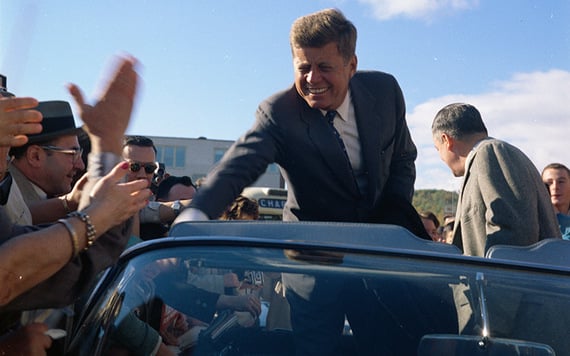
JFk may well have been in pain when pictures such as these of him campaigning were taken.
It is believed that it was a football injury in 1937 that first caused the back pain which plagued JFK from his time in Harvard to the day of his assassination in 1963.
Published in the Journal of Neurosurgery earlier this month, Pait and Dowdy’s article “John F. Kennedy’s back: chronic pain, failed surgeries, and the story of its effects on his life and death” delves into the medical history of the president in granular detail, analyzing the impact that it would have had on his life and whether it came to play any role in his untimely death.
“Low-back pain, just one of Kennedy’s many medical problems, prompted a total of 4 largely unsuccessful surgeries,” they write, deeming him “patently unhealthy from an early age”, a secret they believe was kept by the Kennedy family until 2001.
JFK did everything he could to maintain his image as a young, healthy, dynamic politician while in office and by the time he reached the presidency, he was receiving fad vitamin injections from Dr. Max Jacobson, often named Dr. Feelgood because of his methods.
Despite his initial football injury ruling him out of wartime enlistments in 1940, his father’s political influence was to acquire JFK a commission in the US Naval Reserve in 1941, a commission that would ultimately lead to further damage to his back.
Being declared fit for duty in 1943 and called to the Pacific, a young Kennedy was shipwrecked and stranded when his boat was hit by a Japanese destroyer. He saved the life of a shipmate by pulling him along as he swam with the band of his life jacket held in his teeth. He returned a war hero but the physical exertion of the five-hour swim would have lifelong effects on JFK’s health.
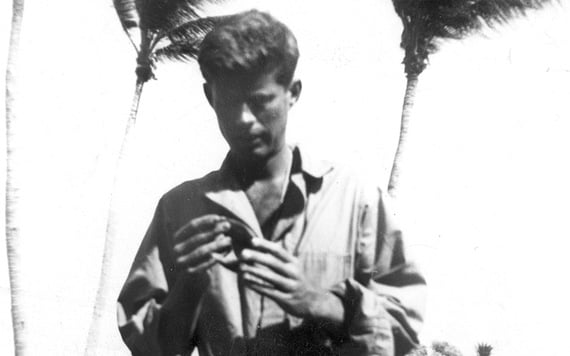
JFK in the Pacific.
It was less than a year later that he underwent the first of the four surgeries on his spine, surgery that was meant to drastically improve his condition but had the complete opposite effect.
On June 23, 1944, the surgeons attempted to remove spongy material in between disks in his spine but he began to experience spasms and the surgery was deemed unsuccessful as a result of the inaccurate imagery used during the procedure. While using air as part of the imaging technique was deemed as offering lower risks of injury, it was also less accurate and so could not adequately solve the problem.
Only two years later in 1946, JFK was first elected to Congress and it was at this time that his health problems began to have a massively detrimental effect on his standard of living.
It was for a completely different issue that Kennedy was first read his last rites, however. Having suffered with long-term gastrointestinal problems, Kennedy was on an overseas trip in London when the corticosteroid tablets stopped working. The abrupt stop in steroids in his system (steroids generally must be fazed out) caused Kennedy a severe adrenal gland crisis and he became quickly and seriously ill.
While he was eventually diagnosed with Addison’s disease, his family were so concerned when he was brought back to the US that the priest was called.
He was to make a recovery but his health problems were far from behind him. His political ambitions could not be stopped, however, and he was elected to the Senate in 1952 after a “gruelling race.”
His political advisor at the time, Dave Powers, even claims that JFK had to move “with crutches, gritting his teeth when he walked” during this Senate campaign.
Read more: John F. Kennedy very likely had celiac disease
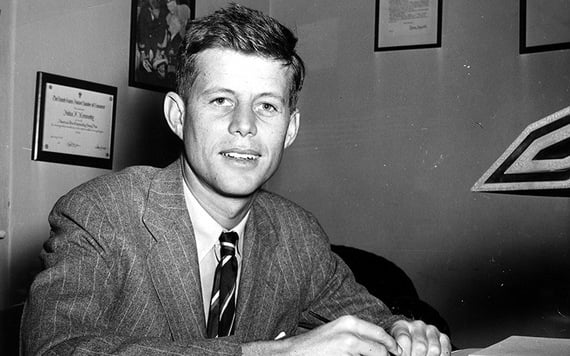
JFK suffered with chronic lower back pain from his time in Harvard until his death.
“But then,” Powers continued,”'when he came into the room where the crowd was gathered, he was erect and smiling, looking as fit and healthy as the light-heavyweight champion of the world. Then after he finished his speech and answered questions from the floor and shook hands with everyone, we would help him into the car and he would lean back on the seat and close his eyes in pain.”
In constant pain and with no improvement in his condition, JFK took a massive risk in undergoing a lumbosacral fusion operation.
The surgery, carried out by. Dr Philip Wilson, Sr., an orthopedic surgeon and Harvard classmate of JFK's father, did not go as planned, leaving the young senator with a UTI so severe it sent him into a coma and with a small wound that would become horribly infected. For the second time, his family called for the priest to read the future president his last rites.
But recover he did, if slowly, and JFK retired to Palm Beach in excruciating pain, often with bones emerging from his back from the wound he had suffered during surgery.
As the wound refused to heal, it became clear that a third surgery was necessary to try to undo the damage caused by the second and in February 1955, the hardware installed in Kennedy’s spine to attempt to fix together vertebrate was again removed.
Doctors began to focus on muscular and environmental factors contributing to his back pain during his long recovery. These methods included injections that numbed the pains in his back and the introduction of Kennedy’s famous rocking chair that would become a recurring feature in his presidency.
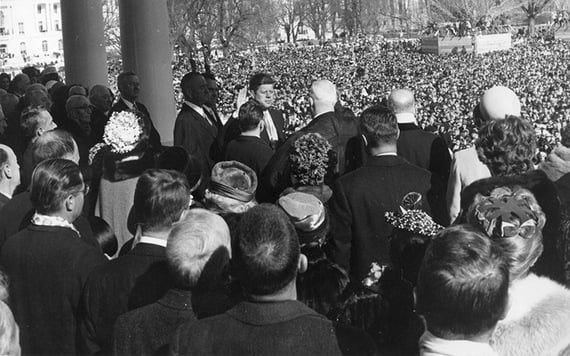
President JFK being sworn in.
Read more: Did JFK's Irish driver cause his death?
Unfortunately, this was still not to be his last back surgery, despite the failure of the previous attempts, and when a “powerful point of redness appeared in the mid-line operative scar of the lumbar spine fusion” in September 1957, Kennedy was admitted to hospital for a special surgery.
The final operation appeared to appease the worst of Kennedy’s pain and he was in relatively good health as he won the presidential election in 1960. The hard campaign trail and life on the road caused JFK to turn to Dr. Feel Good, however, and it was upon entering the White House that he began to receive the illicit injections.
These injections increased after the new President’s back was strained during a tree-planting ceremony in Ottawa and it was this, combined with frequent use of crutches, procaine injections and a corset back brace, that helped him carry out his job.
JFK improved through an new exercise and rehabilitation program but a relapse in August 1963 was the reason why in November 1963 in Dallas, Texas, JFK was wearing a back brace while he sat in his motorcade that may have held him upright while he was shot.
The true extent of JFK’s physical pain is remarkable when put into context with the widely spread image of the young President.
“JFK remains a case study in the complexity of human nature,” the study claims.
“An affluent political scion turned war hero, a serial philanderer and methamphetamine user, a civil-rights supporter and initiator of the Vietnam War who was both the youngest man elected president in the nation’s history and perhaps the 20th century’s least healthy one.”
Has your opinion if JFK changed knowing the extent of pain he felt throughout his Presidency? Let us know your thoughts in the comments section.
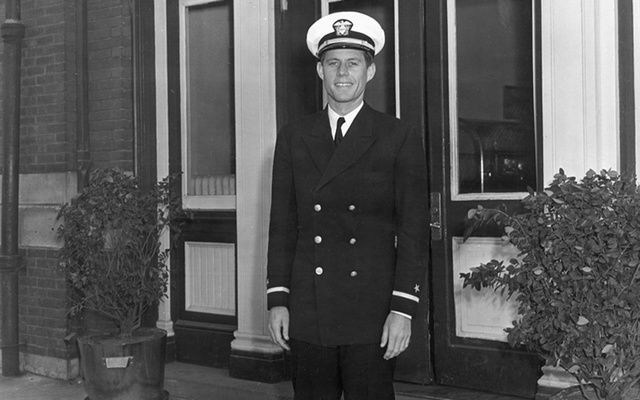



Comments